Ever look around and wonder why cleaning up after a hoarder seems so much more intense than your typical Saturday morning chores? It’s not just about the amount of stuff. Hoarding cleanup and regular cleaning are two totally different beasts, and knowing what sets them apart can make a world of difference.
Let’s break it down and see why the approach matters!
What’s Regular Cleaning, Anyway?
Regular cleaning is your everyday, run-of-the-mill tidying up. Here’s what it usually includes:
– Vacuuming floors
– Dusting shelves and surfaces
– Wiping down counters and tables
– Cleaning bathrooms and kitchens
You probably do these things daily, weekly, or whenever you feel like your place needs a refresh. The main goal? Stop dirt from piling up, keep things germ-free, and make your home a nice place to hang out. If you’re facing a bigger mess, you might turn to a hoarding cleanup company in Minneapolis.
Key points:
– It’s all about routine.
– You’re dealing with a manageable mess.
– Maintenance is easy if you stay consistent.
Hoarding: What’s Really Going On?
Hoarding isn’t about being lazy or messy. It often comes from deep emotional roots.

Why Do People Hoard?
– Emotional Attachments: Maybe those old magazines remind you of your childhood, or that broken toaster was a gift from someone special.
– Anxiety or Trauma: Sometimes, holding onto stuff gives a sense of comfort or control.
– Fear of Waste: “I might need this someday!” Sound familiar?
These feelings make it really tough to let go, even if the clutter is taking over.
Signs of hoarding:
– Difficulty throwing things away, even trash.
– Piles of items blocking doorways or stacking up in every room.
– Stress or embarrassment about the mess.
How Hoarding Impacts Your Space
A hoarded space isn’t just cluttered—it can be downright dangerous:
– Walkways get blocked.
– It’s hard to reach essential areas (like the bathroom or kitchen).
– Stuff piles up, increasing fire risk.
– Mold, pests, and dust can cause health issues.
It’s not just about being messy—it’s a safety and health issue for everyone living there.
Cleaning Techniques: Regular vs. Hoarding Cleanup
Let’s get real—tidying up the living room is nothing like dealing with a house packed wall-to-wall with stuff.
Regular Cleaning Tools
– Basic vacuum
– Mop and broom
– Sponges and wipes
– Regular trash bags
Hoarding Cleanup Tools
– Industrial-strength vacuums (with HEPA filters)
– Heavy-duty gloves and masks (PPE)
– Biohazard bags and containers
– Special scrapers or extraction tools
– Organizational bins for sorting
Cleaning Strategies
Regular Cleaning:
– Quick and simple.
– One pass over the surfaces.
– Focus on visible dirt.
Hoarding Cleanup:
– Multiple passes needed.
– Sorting into “keep,” “donate,” and “trash.”
– Deep cleaning and sanitizing (sometimes mold or animal waste involved).
– Emotional support and patience are key.
Safety and Health: What’s at Stake?
Regular cleaning risks:
– Maybe a slip on a wet floor, or a minor chemical fume headache.
Hoarding cleanup risks:
– Exposure to mold, bacteria, pests, and even biohazards.
– Physical injury from tripping or unstable piles.
– Allergic reactions or respiratory problems.
Must-haves for hoarding situations:
– Gloves, masks, and sometimes even protective suits.
– A plan for handling hazardous materials.
– Sometimes, help from professionals.
When Should You Call in the Pros?
You don’t need a cleaning crew for a little dust bunny under the couch. But for hoarding situations, professional help is often a must.
Call a pro if:
– The clutter blocks exits or creates fire hazards.
– There’s mold, pests, or animal waste.
– You feel overwhelmed or unsafe.
– You spot structural damage or can’t reach important spaces.
Professional cleaners know how to handle dangerous materials and approach the job with compassion.
Emotional Side of Hoarding Cleanup
You can’t just barge in with garbage bags and start tossing things. Hoarding is tied to real emotions—guilt, fear, anxiety, and even shame.
– Understand the “why” behind the clutter.
– Go slow, and be gentle.
– Offer support, not criticism.
Sometimes, therapy or counseling is just as important as the cleanup itself.

Keeping Things Tidy for the Long Haul
Want to avoid falling back into old habits? Here are some tips:
– Make cleaning a regular thing: Set aside 10 minutes a day for tidying.
– Declutter in small bursts: Sort into “keep,” “donate,” and “toss.”
– Use storage bins and labels: Make it easy to stay organized.
– Put things back right after use: Don’t let clutter pile up again.
Staying organized doesn’t have to be hard—consistency is what counts!
The Bottom Line
Regular cleaning and hoarding cleanup aren’t even in the same league. Regular cleaning is about keeping up; hoarding cleanup is about digging out—physically and emotionally. If you or someone you know struggles with hoarding, remember: it’s okay to ask for help. With the right tools, strategies, and support, it’s possible to reclaim a safe, healthy, and comfortable home.
Need help or advice on hoarding cleanup? Don’t hesitate to reach out to professionals who understand the challenges and can offer the support you need.
